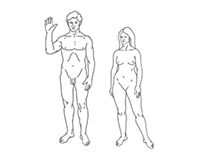The magic lantern or Laterna Magica is an early type of image projector developed in the 17th century. It has a concave mirror in front of a light source that gathers light and projects it through a slide with an image printed on it.
The lens throws an enlarged picture of the original image from the slide onto a screen. The main light sources used during the time it was invented were candles or oil lamps. These light sources were quite inefficient and produced weak projections.
The invention of the Argand lamp in the 1790s helped to make the projected images brighter. The invention of the limelight in the 1820s made it even brighter, and following that the inventions of the electric arc lamp in the 1860s, and then incandescent electric lamps all further improved the projected image of the magic lantern.
It was also an important invention for the motion picture film and 45mm projector because of its ability to screen moving images. To achieve this, mechanical slides were used to make the images move. This was done using two glass slides, one with the part of the picture that would remain stationary and one with the part of the picture that would move on a disc. The glass slides were placed one on top of the other in an orderly fashion and a hand-operated pulley wheel was used to turn the movable disc.
There has been some debate about who the original inventor of the magic lantern is, but the most widely accepted theory is that Dutch mathematician, Christian Huygens, developed the original device in the late 1650s. In the fifteenth century, however, Giovanni Fontana, a Venetian engineer, had already created a lantern that projected an image of a demon. Huygens’s device was even referred to as the ‘lantern of fright’ because it was able to project spooky images that looked like apparitions.
In its early development, it was mostly used by magicians and conjurers to project images, making them appear or disappear, transform from one scene into a different scene, animate normally inanimate objects, or even create the belief of bringing the dead back to life. In the 1660s, a man named Thomas Walgensten used his so-called ‘lantern of fear’ to summon ghosts. These misuses of this early machine were not uncommon. In fact, a common setup of the machine was to keep parts of the projector in a separate, adjoining room with only the aperture visible, to make it seem more magical.
By the 18th century, use by charlatans was common for religious reasons. For example, Count Cagliostro used it to ‘raise dead spirits’ in Egyptian masonry. Johann Georg Schröpfer used the magic lantern to conjure up images of dead people on smoke. He staged routines doing this at his coffee shop in Leipzig. He did this to scare people and make them think he was a good actor. Schröpfer ended up going crazy and thinking he himself was pursued by real devils, and shot himself after promising an audience he would later resurrect himself.
The later part of the 18th century was the age of Romanticism and the Gothic novel. There was an obsession with the bizarre and the supernatural. A man named Paul Philidor was a conjuror who started this ‘black art’ in Vienna. He called his show ‘Schröpferesque Geisterscheinings”’ (Schröpfer-style ghost appearances). In his shows, he used the magic lantern to trick people into thinking he had summoned up spirits of revolutionary figures with the lantern mounted on a trolley. He also summoned ghosts by requests. However, his show was eventually closed by the authorities due to their paranoia.The audiences of these magic lantern shows reacted to the projections with bewilderment. They thought the projections were real dreams, visions, apparitions and ghosts, and the devil.
The next famous conjurer to utilize the magic lantern was Etienne-Gaspard Robertson, a Belgian inventor with an interest in magic. He held his first ‘fantasmagorie’ at Pavillon de l’Echiquier in Paris. He began experimenting in the 1780s with techniques used to make phantasmagorias, which is basically the use of the magic lantern to conjure up supernatural images such as the devil, phantoms, or ghosts. If the images were projected onto a gauze screen, they would even seem to be floating in air. At Pavillon de l’Echiquier, Robertson set up a public phantasmagoria and told the audience he would conjure up their dead relatives. He called his magic lantern a fantascope.
The Daily Omnivore
Everything is Interesting



Leave a comment